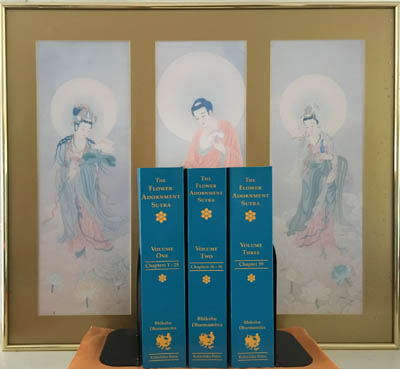



Translations of Buddhist Classics from the Indian and Chinese Traditions
Kalavinka Buddhist Classics
Book 1 - The Flower Adornment Sutra (The Avataṃsaka Sūtra)
Book 2 - Nāgārjuna's Treatise on the Ten Bodhisattva Grounds (The Daśabhūmika Vibhāṣā)
Book 3 - The Ten Grounds Sutra (The Daśabhūmika Sūtra)
Book 4 - The Ten Bodhisattva Grounds (The Avataṃsaka Sūtra, Ch. 26)
Book 5 - Nāgārjuna on Mindfulness of the Buddha
Book 6 - The Essentials of Buddhist Meditation (by Tiantai Master Zhiyi)
Book 7 - The Six Dharma Gates to the Sublime (by Tiantai Master Zhiyi)
Book 8 - Nāgārjuna's Guide to the Bodhisattva Path (The Bodhisaṃbhāra Śāstra)
Book 9 - The Bodhisaṃbhāra Treatise Commentary (By Bhikshu Vaśitva, c. 400ce)
Book 10 - Nāgārjuna on the Six Perfections
Book 11 - A Strand of Dharma Jewels (Nāgārjuna's Ratnāvalī)
Book 12 - Letter from a Friend (Nāgārjuna's Suhṛllekha)
Book 13 - Marvelous Stories from the Perfection of Wisdom
Book 14 - On Generating the Resolve to Become a Buddha
Book 15 - Vasubandhu's Treatise on the Bodhisattva Vow
Book 16 - The Bodhisattva's Practice of Moral Virtue (The Brahmā's Net Sutra Bodhisattva Precepts)
See Directly Below for:
A Complete Translation of the Avataṃsaka Sutra !!!
(10/01/2022)

The Flower Adornment Sutra
An Annotated Translation of the Avataṃsaka Sutra
With a Commentarial Synopsis of the Flower Adornment Sutra
(In Three Volumes, 2,500 pages.)
"The Flower Adornment Sutra" is the first and so far only complete English translation of any edition of the Avataṃsaka Sutra, the very long collection of bodhisattva path teachings considered to be so complete that it was otherwise traditionally referred to as "the Bodhisattva Canon." Bhikshu Dharmamitra has translated it from Tripitaka Master Śikṣānanda’s 80-fascicle circa 699 ce Chinese rendering of the Sanskrit Mahāvaipulya Buddha Avataṃsaka Sūtra (T0279: 大方廣佛華嚴經). This most complete Tang Dynasty edition of the sutra consists of 39 chapters to which Dharmamitra has added the traditionally appended conclusion to Chapter 39, "The Conduct and Vows of Samantabhadra" that was only finally translated into Chinese a century later (798 ce) by Tripitaka Master Prajñā.
The scenarious that unfold across the course of these 39 chapters introduce an interpenetrating, infinitely expansive, and majestically grand multiverse of countless buddha worlds extending throughout all three periods of time and all dimensions of space, revealing as it does so a cosmos in which all phenomena are visible in any given phenomenon and any given phenomenon is visible in all phenomena, more or less analogous to the vision of the cosmos inferred by the revelations of modern physics in its descriptions of quantum entanglement and quantum non-locality. Meanwhile, the text proceeds to reveal and explain in great detail and with countless cases the cultivation of the bodhisattva path to buddhahood, most notably the ten highest levels of bodhisattva practice known as "the ten bodhisattva grounds."
To aid deeper understanding of the sutra and to clarify the rationale for emendations based on variant readings in different Chinese editions, Bhikshu Dharmamitra has included 1200 endnotes while also appending his "A Commentarial Synopsis of the Flower Adornment Sutra" which serves to assist the student in easily reviewing the content and meaning of each of the forty chapters, some of which run in length to hundreds of pages or even, as in the case of the final chapter, seven hundred pages. Other important and useful sections include a relatively brief introduction, a list of abbreviations, and a glossary of the standard Buddhist technical terminology used throughout all three volumes.

(10/01/2022)
The Flower Adornment Sutra - Volume One
An Annotated Translation of the Avataṃsaka Sutra
With a Commentarial Synopsis of the Flower Adornment Sutra
Volume One consists of Chapters 1 - 25.
(Click here to see the Volume One Book Page & Table of Contents.)
Purchase Volume One from Amazon.com: $26.94

(10/01/2022)
The Flower Adornment Sutra - Volume Two
An Annotated Translation of the Avataṃsaka Sutra
With a Commentarial Synopsis of the Flower Adornment Sutra
Volume Two consists of Chapters 26 - 38.
(Click here to see the Volume Two Book Page & Table of Contents.)
Purchase Volume Two from Amazon.com: $24.07

(10/01/2022)
The Flower Adornment Sutra - Volume Three
An Annotated Translation of the Avataṃsaka Sutra
With a Commentarial Synopsis of the Flower Adornment Sutra
Volume Three consists of the 53-part Ch. 39, "Entering the Dharma Realm" (the Gaṇḍavyūha) together with the traditionally appended "Conduct and Vows of Samantabhadra."
(Click here to see the Volume Three Book Page & Table of Contents.)
Purchase Volume Three from Amazon.com: $27.00
Other Recently Published Bodhisattva Path Texts:
Nāgārjuna's Treatise on the Ten Bodhisattva Grounds - Bilingual
(Bilingual Chinese-English Edition)
By Ārya Nāgārjuna (ca 2nd c.)
Nāgārjuna's Daśabhūmika Vibhāṣā
"Nāgārjuna’s Treatise on the Ten Bodhisattva Grounds" is Bhikshu Dharmamitra’s translation of Nāgārjuna’s Daśabhūmika Vibhāṣā, a commentary on the Ten Grounds Sutra. It consists of 35 chapters that explain the cultivation of the ten highest levels of bodhisattva practice leading to buddhahood, focusing almost exclusively on the first two of the ten bodhisattva grounds.
This special bilingual edition (English / Chinese) includes facing-page simplified and traditional Chinese scripts.

(01/01/2020)
Nāgārjuna's Treatise on the Ten Bodhisattva Grounds
(English Edition)
By Ārya Nāgārjuna (ca 2nd c.)
Nāgārjuna's Daśabhūmika Vibhāṣā
"Nāgārjuna’s Treatise on the Ten Bodhisattva Grounds" is Bhikshu Dharmamitra’s translation of Nāgārjuna’s Daśabhūmika Vibhāṣā, a commentary on the Ten Grounds Sutra. It consists of 35 chapters that explain the cultivation of the ten highest levels of bodhisattva practice leading to buddhahood, focusing especially on the first two of the ten bodhisattva grounds.
The Ten Grounds Sutra - Trilingual
(Trilingual Chinese-English-Sanskrit Edition)
The Daśabhūmika Sūtra
"The Ten Grounds Sutra (Trilingual)" is an annotated English Translation by Bhikshu Dharmamitra of Tripitaka Master Kumārajīva’s circa 410 ce Sanskrit-to-Chinese translation of the Daśabhūmika Sūtra. This sutra describes in great detail the ten highest levels of bodhisattva practice on the path to buddhahood.
This special trilingual edition (English / Chinese / Sanskrit) includes the facing-page simplified and traditional Chinese scripts along with the entire appended P. L. Vaidya Sanskrit text.
(English Edition)
The Daśabhūmika Sūtra
"The Ten Grounds Sutra" is an annotated English Translation by Bhikshu Dharmamitra of Tripitaka Master Kumārajīva’s circa 410 ce Sanskrit-to-Chinese translation of the Daśabhūmika Sūtra. This sutra describes in great detail the ten highest levels of bodhisattva practice on the path to buddhahood.
This otherwise "English-only" edition includes as an appendix the entire P. L. Vaidya Sanskrit text.
The Ten Bodhisattva Grounds - Trilingual
(Trilingual Chinese-English-Sanskrit Edition)
The Avataṃsaka Sūtra, Chapter 26
"The Ten Bodhisattva Grounds" is an annotated English Translation by Bhikshu Dharmamitra of Tripitaka Master Śikṣānanda’s circa 699 ce Sanskrit-to-Chinese translation of the Avataṃsaka Sūtra, Chapter 26, "The Ten Grounds Chapter." This text describes in great detail the ten highest levels of bodhisattva practice on the path to buddhahood as taught in that sutra.
This special trilingual edition (English / Chinese / Sanskrit) includes facing-page simplified and traditional Chinese scripts along with the entire appended P. L. Vaidya Sanskrit text.
(English Edition)
The Avataṃsaka Sūtra, Chapter 26
”The Ten Bodhisattva Grounds” is an annotated English Translation by Bhikshu Dharmamitra of Tripitaka Master Śikṣānanda’s circa 699 ce Sanskrit-to-Chinese translation of the Avataṃsaka Sūtra, Chapter 26, "The Ten Grounds Chapter." This text describes in great detail the ten highest levels of bodhisattva practice on the path to buddhahood as taught in that sutra.
This otherwise "English-only" edition of the translation includes as an appendix the entire P. L. Vaidya Sanskrit text.
(Bilingual Chinese-English Edition)
By Ārya Nāgārjuna (ca 2nd c.)
“Nāgārjuna on Mindfulness of the Buddha” consists of Bhikshu Dharmamitra's translations of Ārya Nāgārjuna’s explanations of three closely related but rather different "mindfulness-of-the-Buddha" practices that are sometimes conflated with each other: “Mindfulness of the Buddha” as pure land practice; “Mindfulness of the Buddhas” as cultivation of the “seeing-the-Buddhas” (pratyutpanna) samādhi; and “Recollection of the Buddha” as a protective practice. The first two explanations are drawn from Nāgārjuna’s Daśabhūmika Vibhāṣā and the third explanation is drawn from Nāgārjuna’s Mahāprājnāpāramitā Upadeśa.
This special bilingual edition (English / Chinese) includes facing-page simplified and traditional Chinese scripts.
(English Edition)
By Ārya Nāgārjuna (ca 2nd c.)
“Nāgārjuna on Mindfulness of the Buddha” consists of Bhikshu Dharmamitra's translations of Ārya Nāgārjuna’s explanations of three closely related but rather different "mindfulness-of-the-Buddha" practices that are sometimes conflated with each other: “Mindfulness of the Buddha” as pure land practice; “Mindfulness of the Buddhas” as cultivation of the “seeing-the-Buddhas” (pratyutpanna) samādhi; and “Recollection of the Buddha” as a protective practice. The first two explanations are drawn from Nāgārjuna’s Daśabhūmika Vibhāṣā and the third explanation is drawn from Nāgārjuna’s Mahāprājnāpāramitā Upadeśa.
Meditation Instruction Texts:

* The Essentials of Buddhist Meditation *
By Śramaṇa Zhiyi (Chih-i) - (538-597 ce)
Master Zhiyi is the famous Tiantai Mountain meditation master, exegete, and teachings-school founder. His "Essentials of Buddhist Meditation" or "Essentials for Practicing Calming-and-Insight and Dhyana Meditation" is a calming-and-insight (śamatha-vipaśyanā) meditation manual deeply rooted in the early Indian Buddhist meditation tradition. It offers perhaps the most reliable, comprehensive, and practically-useful Buddhist meditation instruction currently available in English.
Translation by Bhikshu Dharmamitra. Includes facing-page source text.

* The Six Dharma Gates to the Sublime *
By Śramaṇa Zhiyi (Chih-i) - (538-597 ce)
This classic, also by Master Zhiyi, serves as an ideal companion volume to The Essentials of Buddhist Meditation. "The Six Dharma Gates to the Sublime" explains the six practices crucial to success in traditional Indian Buddhist breath (ānāpāna) and calming-and-insight (śamatha-vipaśyanā) meditation. Correctly implemented, these six "gates" lead the practitioner to realize the third of the four truths (cessation), of which the "sublimity" referenced in the title is one of the four canonically-described practice aspects.
Translation by Bhikshu Dharmamitra. Includes facing-page source text.
Previously Published Bodhisattva Path Texts:

* Nāgārjuna's Guide to the Bodhisattva Path *
By Ārya Nāgārjuna (ca 2nd c.)
Nāgārjuna's Bodhisaṃbhāra Śāstra with Abridged Bhikshu Vasitva Commentary.
"Nāgārjuna's Guide to the Bodhisattva Path" is Nāgārjuna's Bodhisaṃbhāra Śāstra ("Treatise on the Provisions for Path to Enlightenment"). It describes the essential prerequisites for the complete enlightenment of a buddha. It is accompanied here by an abridged version of its only commentary, originally written by the early Indian Bhikshu Vaśitva.
Translation, abridgement, and notes by Bhikshu Dharmamitra. Includes facing-page source text.

* The Bodhisaṃbhāra Treatise Commentary *
By the early Indian monk, Bhikshu Vaśitva (ca 300-500 ce)
"The Bodhisaṃbhāra Treatise Commentary" is a very detailed commentary on the meaning of each stanza comprising Ārya Nāgārjuna's Treatise on the Provisions for the Path to Enlightenment. It is the only extant traditional commentary on this important work by Nāgārjuna.
Translation and clarifying notes by Bhikshu Dharmamitra. Includes facing-page source text.

* Nāgārjuna on the Six Perfections *
By Ārya Nāgārjuna
"Nāgārjuna on the Six Perfections" is is a translation of chapters 17-30 of Ārya Nāgārjuna's Exegesis on the Great Perfection of Wisdom Sutra, a free-standing section exclusively devoted to analyzing and explaining the bodhisattva's six perfections. Nāgārjuna sets forth stories, analogies, and analyses as he discourses on the six primary practices forming the core of the Bodhisattva Path.
Translation by Bhikshu Dharmamitra. Includes facing-page source text.

By Ārya Nāgārjuna
"A Strand of Dharma Jewels" is Tripitaka Master Paramartha's earliest (ca 550 ce) complete edition of Nāgārjuna's Ratnāvalī, a 500-stanza treatise on the Bodhisattva Path presented in the form of a spiritual advisor's letter to an Indian King. In it, Nāgārjuna presents both abstruse teachings and practical advice to lay and monastic practitioners.
Translation by Bhikshu Dharmamitra. Includes facing-page source text.

*
Letter from a Friend *
"Letter from a Friend" consists of the Three
Earliest Editions of Nāgārjuna's
Suhṛllekha,
Nāgārjuna's spiritual counsel to an Indian monarch.
By Ārya Nāgārjuna
As translated by Tripitaka
Master Guṇavarman (ca 425)
As translated by Tripitaka Master Saṃghavarman (ca
450)
As translated by Tripitaka Master Yijing
(ca 675)
English translations with notes by Bhikshu Dharmamitra. Includes facing-page source text.

* Marvelous Stories from the Perfection of Wisdom *
As told by Ārya Nāgārjuna
"Marvelous Stories from the Perfection of Wisdom" consists of 130 stories and short Dharma anecdotes selected from Nāgārjuna's immense commentary on the Great Perfection of Wisdom Sutra. Each story is "framed" by the inclusion of Nāgārjuna's introductory and summarizing Dharma discussions.
Translation by Bhikshu Dharmamitra. Includes facing-page source text.
Resolve-for-Enlightenment / Bodhicitta Texts:

*
On Generating the Resolve to Become a Buddha *
"On Generating the Resolve to Become a Buddha," three works on bodhicitta:
By Ārya Nāgārjuna, Patriarch Sheng'an Shixian, and the Tang-Dynasty literatus, Peixiu.
--On Generating the Resolve to Become a Buddha. By Ārya Nāgārjuna. (Ch. 6 of The Ten Grounds Vibhāṣā)
--Exhortation to Resolve on Buddhahood. By Dhyana Master Sheng'an Shixian. (1686-1734)
--Exhortation to Resolve on Buddhahood. By the Tang Dynasty literatus, Peixiu. (797-870)
Translations by Bhikshu Dharmamitra. Includes facing-page source text.

* Vasubandhu's Treatise on the Bodhisattva Vow *
By Vasubandhu Bodhisattva (ca 300)
"Vasubandhu's Treatise on the Bodhisattva Vow" is Vasubandhu's treatise on the The Sutra on Generating the Resolve to Become a Buddha in which Vasubandhu discourses on the causality behind the origination of the bodhisattva vow (bodhicitta) and on the six perfections through which it reaches fruition.
Translation by Bhikshu Dharmamitra. Includes facing-page source text.
Bodhisattva Moral Virtue (Śīla) Texts:

*
The Bodhisattva's
Practice of Moral Virtue * New !!! (07/01/2024)
"The Bodhisattva's Practice of Moral Virtue" consists of the Bodhisattva's
Moral Code, It's Recitation Ceremony, and Nāgārjuna's Synopsis of the
Nature and Practice of the Bodhisattva's Perfection of Moral Virtue.
--The Brahma's Net Sutra Bodhisattva Precepts
--The Semimonthly Bodhisattva Precepts Recitation Ceremony
--Nāgārjuna on the Perfection of Moral Virtue
Translations by Bhikshu Dharmamitra. Includes facing-page source text.






